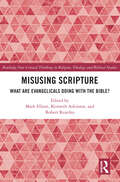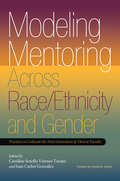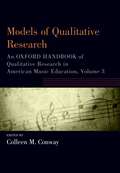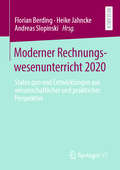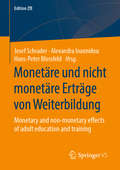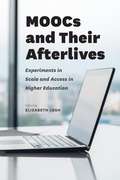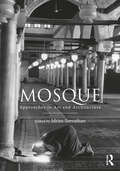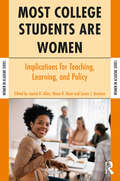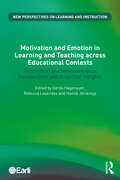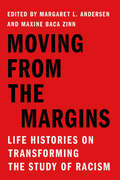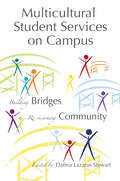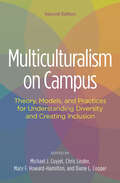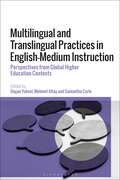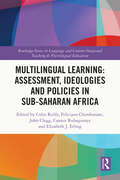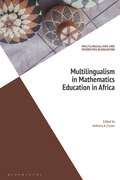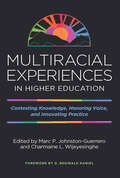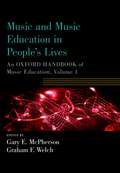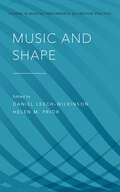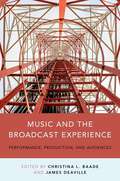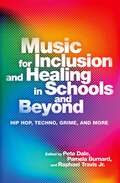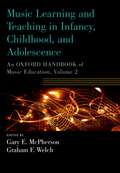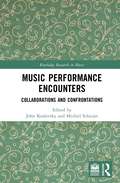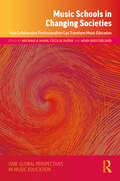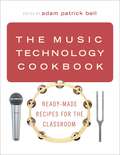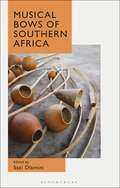- Table View
- List View
Misusing Scripture: What are Evangelicals Doing with the Bible? (Routledge New Critical Thinking in Religion, Theology and Biblical Studies)
Misusing Scripture offers a thorough and critical evaluation of American evangelical scholarship on the Bible. This strand of scholarship exerts enormous influence on the religious beliefs and practices, and even cultural and political perspectives, of millions of evangelical Christians in the United States and worldwide. The book brings together a diverse array of authors with expertise on the Bible, religion, history, and archaeology to critique the nature and growth of "faith-based" biblical scholarship. The chapters focus on inerrancy and textual criticism, archaeology and history, and the Bible in its ancient and contemporary contexts. They explore how evangelicals approach the Bible in their biblical interpretation, how "biblical" archaeology is misused to bolster distinctive views about the Bible, and how disputed interpretations of the Bible impact issues in the public square. This unique and timely volume contributes to a greater understanding and appreciation of how contemporary American evangelicals understand and use the Bible in their private and public lives. It will be of particular interest to scholars of biblical studies, evangelical Christianity, and religion in the United States.
Modeling Mentoring Across Race/Ethnicity and Gender: Practices to Cultivate the Next Generation of Diverse Faculty
While mentorship has been shown to be critical in helping graduate students persist and complete their studies, and enter upon and succeed in their academic careers, the under-representation of faculty of color and women in higher education greatly reduces the opportunities for graduate students from these selfsame groups to find mentors of their race, ethnicity or gender.Recognizing that mentoring across gender, race and ethnicity inserts levels of complexity to this important process, this book both fills a major gap in the literature and provides an in-depth look at successful mentorships between senior white and under-represented scholars and emerging women scholars and scholars of color. Following a comprehensive review of the literature, this book presents chapters written by scholars who share in-depth descriptions of their cross-gender and/or cross-race/ethnicity mentoring relationships. Each article is co-authored by mentors who are established senior scholars and their former protégés with whom they have continuing collegial relationships. Their descriptions provide rich insights into the importance of these relationships, and for developing the academic pipeline for women scholars and scholars of color. Drawing on a comparative analysis of the literature and of the narrative chapters, the editors conclude by identifying the key characteristics and pathways for developing successful mentoring relationships across race, ethnicity or gender, and by offering recommendations for institutional policy and individual mentoring practice. For administrators and faculty concerned about diversity in graduate programs and academic departments, they offer clear models of how to nurture the productive scholars and teachers needed for tomorrow’s demographic of students; for under-represented students, they offer compelling narratives about the rewards and challenges of good mentorship to inform their expectations and the relationships they will develop as protégés.
Models of Qualitative Research: An Oxford Handbook of Qualitative Research in American Music Education, Volume 3 (Oxford Handbooks)
New in paperback, the articles collected in Models of Qualitative Research examine the use of qualitative research in answering important research questions regarding music teaching and learning in a variety of diverse music education contexts. Each author examines key studies and provides suggestions for future questions that qualitative researchers may consider. Contexts examined in the chapter include: early childhood music, general music, instrumental music -winds, brass percussion, instrumental music-strings, choral music, preservice teacher education, teacher professional development, community music education, music for students with special needs, music education and issues of diversity, and world music. Models of Qualitative Research is the third of three paperback volumes derived from the original Oxford Handbook of Qualitative Research in American Music Education, which outlines the history of qualitative research in music education and explores the contemporary use of qualitative approaches in examining issues related to music teaching and learning.
Moderner Rechnungswesenunterricht 2020: Status quo und Entwicklungen aus wissenschaftlicher und praktischer Perspektive
Der Rechnungswesenunterricht macht in den Curricula der 55 kaufmännischen Ausbildungsberufe ca. 38 Prozent der Inhalte aus – dennoch zeigen Studien der vergangenen Jahrzehnte Lernschwierigkeiten in diesem Bereich. Gleichzeitig verändern sich im Zuge der Digitalisierung die Anforderungen in der Praxis an den Umgang mit dem „Werkzeug“ Rechnungswesen. Die Autor*innen fassen vor diesem Hintergrund die Forschungsergebnisse zum Rechnungswesenunterricht der vergangenen Jahrzehnte zusammen und geben Einblicke in mögliche zukünftige Entwicklungen aus der Perspektive von Betrieben, Schulen und Hochschulen.
Monetäre und nicht monetäre Erträge von Weiterbildung: Monetary and non-monetary effects of adult education and training (Edition ZfE #7)
Im Zentrum des Bandes stehen monetäre und nicht-monetäre Erträge von Weiterbildung, die sich auf dem Arbeitsmarkt, im Einkommen oder auch im zivilgesellschaftlichen Engagement zeigen. Trotz der thematischen und institutionellen Vielfalt der Weiterbildung und der Unterschiedlichkeit der damit einhergehenden Erwartungen stellen sich die Autorinnen und Autoren der Herausforderung, kausale Wirkungszusammenhänge zu identifizieren. Impulse dafür bietet der Vergleich der vorgestellten internationalen Analysen.
MOOCs and Their Afterlives: Experiments in Scale and Access in Higher Education
A trio of headlines in the Chronicle of Higher Education seem to say it all: in 2013, “A Bold Move Toward MOOCs Sends Shock Waves;” in 2014, “Doubts About MOOCs Continue to Rise,” and in 2015, “The MOOC Hype Fades.” At the beginning of the 2010s, MOOCs, or Massive Open Online Courses, seemed poised to completely revolutionize higher education. But now, just a few years into the revolution, educators’ enthusiasm seems to have cooled. As advocates and critics try to make sense of the rise and fall of these courses, both groups are united by one question: Where do we go from here? Elizabeth Losh has gathered experts from across disciplines—education, rhetoric, philosophy, literary studies, history, computer science, and journalism—to tease out lessons and chart a course into the future of open, online education. Instructors talk about what worked and what didn’t. Students share their experiences as participants. And scholars consider the ethics of this education. The collection goes beyond MOOCs to cover variants such as hybrid or blended courses, SPOCs (Small Personalized Online Courses), and DOCCs (Distributed Open Collaborative Course). Together, these essays provide a unique, even-handed look at the MOOC movement and will serve as a thoughtful guide to those shaping the next steps for open education.
Mosque: Approaches to Art and Architecture
Mosque examines the history, culture, evolution and functions of the Muslim house of worship through the prism of its artistic objects and architectural elements. Contributors present a range of elements, from dome to mihrab, to mosque furniture including lamps, prayer rugs and Qur’an stands. In addition, the book draws attention to the importance of mosque heritage through special projects and initiatives that study, preserve and revitalize the traditional arts of the mosque. This unique book brings together prominent architects, art historians, artists, historians and curators to explore innovative approaches towards the study of mosques through the presentation of original research and insights about mosque-related cultural objects. It is essential reading for anyone interested in the art and culture of the Muslim world.
Most College Students Are Women: Implications for Teaching, Learning, and Policy
* Reveals continuing barriers to success for women students* Offers remedies that will benefit all studentsWhat are the realities behind recent press reports suggesting that women students have taken over higher education, both outnumbering males and academically outperforming them? Does women’s development during college diverge from the commonly accepted model of cognitive growth? Does pedagogy in higher education take into account their different ways of knowing? Are there still barriers to women’s educational achievement? In answering these questions, this book’s overarching message is that the application of research on women’s college experiences has enriched teaching and learning for all students. It describes the broad benefits of new pedagogical models, and how feminist education aligns with the new call for civic education for all students. The book also examines conditions and disciplines that remain barriers for women’s educational success, particularly in quantitative and scientific fields. It explores problems that arise at the intersection of race and gender and offers some transformative approaches. It considers the impact of the campus environment—such as the rise of binge drinking, sexual assault, and homophobic behaviors—on women students’ progress, and suggests means for improving the peer culture for all students. It concludes with an auto-narrative analysis of teaching women's studies to undergraduates that offers insights into the practicalities and joys of teaching. At a time when women constitute the majority of students on most campuses, this book offers insights for all teachers, male and female, into how to help them to excel; and at the same time how to engage all their students, in all their diversity, through the application of feminist pedagogy.
Motivation and Emotion in Learning and Teaching across Educational Contexts: Theoretical and Methodological Perspectives and Empirical Insights (New Perspectives on Learning and Instruction)
Motivation and Emotion in Learning and Teaching across Educational Contexts brings together current theoretical and methodological perspectives as well as examples of empirical implementations from leading international researchers focusing on the context specificity and situatedness of their core theories in motivation and emotion. The book is compiled of two main sections. Section I covers theoretical reflections and perspectives on the main theories on emotion and motivation in learning and teaching and their transferability across different educational contexts illustrated with empirical examples. Section II addresses the methodological reflections and perspectives on the methodology that is needed to address the complexity and context specificity of motivation and emotion. In addition to general reflections and perspectives regarding methodology, concrete empirical examples are provided. All cutting-edge chapters include current empirical studies on emotions and motivation in learning and teaching across different contexts (age groups, domains, countries, etc.) making them applicable and relevant to a wide range of contexts and settings. This high-quality volume with contributions from leading international experts will be an essential resource for researchers, students and teacher trainers interested in the vital role that motivation and emotions can play in education.
Moving from the Margins: Life Histories on Transforming the Study of Racism (Stanford Studies in Comparative Race and Ethnicity)
At a time when movements for racial justice are front and center in U.S. national politics, this book provides essential new understanding to the study of race, its influence on people's lives, and what we can do to address the persistent and foundational American problem of systemic racism. Knowledge about race and racism changes as social and historical conditions evolve, as different generations of scholars experience unique societal conditions, and as new voices from those who have previously been kept at the margins have challenged us to reconceive our thinking about race and ethnicity. In this collection of essays by prominent sociologists whose work has transformed the understanding of race and ethnicity, each reflects on their career and how their personal experiences have shaped their contribution to understanding racism, both in scholarly and public debate. Merging biography, memoir, and sociohistorical analysis, these essays provide vital insight into the influence of race on people's perspectives and opportunities both inside and outside of academia, and how racial inequality is felt, experienced, and confronted.
Multicultural Student Services on Campus: Building Bridges, Re-visioning Community (An ACPA Co-Publication)
Co-published with For new professionals in multicultural student services (MSS), this book constitutes a thorough introduction to the structure, organization, and scope of the services and educational mission of these units. For senior practitioners it offers insights for re-evaluating their strategies, and inspiration to explore new possibilities.The book discusses the history and philosophy of MSS units; describes their operation; asserts the need for integration and coherence across the multiple facets of their work and how their role is influenced by the character and type of their institutions; and considers the challenges and opportunities ahead. The theme Building Bridges, Re-Visioning Community reflects the dual role of MSS. They “build bridges” between underrepresented student populations and the broader institutional environment, between different groups of student populations, and across differences in cultural values and traditions. At a time of increasing diversity on campus, their role is also to champion the “re-visioning” or redefinition of what constitutes community in higher education – in other words to reach beyond serving their traditional constituencies to educate for multicultural competence, and advocate for social justice across the campus commons.This book is organized in four sections moving the reader from the past to the present to the future, and from a service mission to an educational one. Part One reviews the purposes for which MSS were created, and the evolution of their vision, concluding an overview of how units perceive their needs and challenges today.Part Two addresses a range of issues – such as race/ethnicity, sexual orientation / gender identity, and religion/faith diversity – commonly addressed by MSS, and, in recognizing the tensions inherent in serving such disparate constituencies, advances ideas for bringing greater integration and coherence to their work.Part Three considers how institutional context influences the structure and organization of MSS, and addresses such questions as: Who are they serving? What kind of support services and educational programming can they provide? How broadly or narrowly should they define their role, and can they extend their influence through alliances with other campus units?The book concludes by looking at how MSS can re-vision community to ensure their continued relevance to the college or university community.An ACPA Publication
Multiculturalism on Campus: Theory, Models, and Practices for Understanding Diversity and Creating Inclusion
The first edition of this book constituted a comprehensive resource for students of higher education, faculty, higher education administrators and student affairs leaders engaging with multiculturalism and diverse populations on college campuses. It was one of the first texts to gather in a single volume the related theories, assessment methods, and environmental and application issues pertinent to the study and practice of multiculturalism, while also offering approaches to enhancing multicultural programming and culturally diverse campus environments. This second edition retains the structure and vision of the first, introducing readers to the key theories and models for understanding the complexity of the students they serve, and for reflecting on their own values and motivations. It provides an array of case studies, discussion questions, examples of best practice, and recommendations about resources for use in the classroom. This edition includes a new chapter on intersectionality, updates several chapters, presents a number of new cultural frameworks and updated best practices for creating an inclusive environment for marginalized groups, and expands the third section of the book on cultural competent practice.
Multilingual and Translingual Practices in English-Medium Instruction: Perspectives from Global Higher Education Contexts
English Medium Instruction (EMI) refers to the use of the English language to teach academic subjects where first language of the majority of the population is not English. One popular implementation of EMI, the Multilingual Model, would imply that some aspects (e.g. courses, sessions in some courses, and/or assessment) are taught through English, whereas the first language of the students is used in some other respects. This volume explores context-related ways in which the multilingual EMI model and translingual practices are seen and enacted in higher education contexts across the globe. Research on this topic is not only timely but also very much needed, particularly in contexts that are relatively new to EMI, as well as in contexts where monolingual forms of teaching and monolingual institutional policies still prevail. Empirical, research-based studies as well as theoretical reviews that centre around multilingual and translingual practices in partial and full (i.e. English-only) EMI settings are elaborated, with case studies from Colombia, Indonesia, Iraq, Norway, Qatar, Spain, Turkey, United Arab Emirates, the UK and the USA.
Multilingual Learning: Assessment, Ideologies and Policies in Sub-Saharan Africa (Routledge Series in Language and Content Integrated Teaching & Plurilingual Education)
This edited volume provides the follow up to Erling et al.’s (2021) Multilingual Learning and Language Supportive Pedagogies in Sub-Saharan Africa. The strategies put forward in Volume 1 included multilingual pedagogies that allow students to draw on their full linguistic repertoires, translanguaging and other language supportive pedagogies. While there is great traction in the pedagogical strategies proposed in Volume 1, limited progress has been made in terms of multilingual education in SSA. Thus, the main focus of this follow-up volume is to explore the question of why former colonial languages and monolingual approaches continue to be used as the dominant languages of education, even when we have multilingual pedagogies and materials that could and do work and despite substantial evidence that learners have difficulties when taught in a language they do not understand. This book offers perspectives to answer this question through focusing on the internal and external pressures which impact the capacity for implementing multilingual strategies in educational contexts at regional, national, and community levels. Chapters provide insights into how to better understand and work within these contemporary constraints and challenge dominant monoglossic discourses which inhibit the implementation of multilingual education in SSA. The volume focuses on three main areas which have proven to be stumbling blocks to the effective implementation of multilingual education to date, namely: Assessment, Ideology and Policy. An insightful collection that will be of great interest to academics, researchers, and practitioners in the fields of language education, language-in-education policy and educational assessments in the wide range of multilingual contexts in Africa.
Multilingualism in Mathematics Education in Africa (Multilingualisms and Diversities in Education)
This book brings together the first book collection of African research in mathematics education in multilingual societies andchronicles current research in different linguistic contexts across the African continent, (including Algeria, Namibia, Malawi, Morocco, Rwanda, South Africa) on issues of multilingualism in mathematics education, but more importantly, it foregrounds pertinent issues for future research. With many of the authors building on earlier path-breaking African research, the book is a unique contribution of careful thinking through how linguistic diversity and multilingualism manifest in ways that differ from one geopolitical context to another. This volume is an important contribution to the growing recognition of multilingualism as the global 'linguistic dispensation' in mathematics education. It is an invitation to how we might (as an international community where more and more multilingualism is the norm rather than an exception) pay more attention to the multilingual agency and capabilities of both students and teachers in order to better harness the epistemic potential of multiple languages in contexts of language diversity in mathematics education.
Multiracial Experiences in Higher Education: Contesting Knowledge, Honoring Voice, and Innovating Practice
Recipient of the 2021 Innovation Award of The Multiracial Network (MRN)In the last Census, over 9 million people – nearly 3% of the population – identified themselves as of two or more races. The proportion of college students who identify as Multiracial is somewhat higher, and growing. Although increasing at a slightly slower rate, Multiracial faculty and staff are also teaching and working on campuses in greater numbers. Together, Multiracial people from diverse backgrounds and in various roles are influencing college and university culture, practices, and climate.This book centers the experiences of Multiracial people, those individuals claiming heritage and membership in two or more (mono)racial groups and/or identifies with a Multiracial term. These terms include the broader biracial, multiethnic, and mixed, or more specific terms like Blasian and Mexipino.In addressing the recurring experiences of inclusion, exclusion, affirmation, and challenges that they encounter, the contributors identify the multiple sites in higher education that affect personal perceptions of self, belonging, rejection, and resilience; describe strategies they utilized to support themselves or other Multiracial people at their institutions; and to advocate for greater awareness of Multiracial issues and a commitment to institutional change.In covering an array of Multiracial experiences, the book brings together a range of voices, social identities (including race), ages, perspectives, and approaches. The chapter authors present a multiplicity of views because, as the book exemplifies, multiracial people are not a monolithic group, nor are their issues and needs universal to all.The book opens by outlining the literature and theoretical frameworks that provide context and foundations for the chapters that follow. It then presents a range of first person narratives – reflecting the experiences of students, faculty, and staff – that highlight navigating to and through higher education from diverse standpoints and positionalities. The final section offers multiple strategies and applied methods that can be used to enhance Multiracial inclusion through research, curriculum, and practice. The editors conclude with recommendations for future scholarship and practice.This book invites Multiracial readers, their allies, and those people who interact with and influence the daily lives of Multiracial people to explore issues of identity and self-care, build coalitions on campus, and advocate for change. For administrators, student affairs personnel, and anyone concerned with diversity on campus, it opens a window on a growing population with whom they may be unfamiliar, mis-categorize, or overlook, and on the need to change systems and structures to address their full inclusion and unveil their full impact.Contributors:e alexanderRebecca CepedaLisa CombsWei Ming DariotisNick DavisKira DonnellChelsea Guillermo-WannJessica C. HarrisAndrew JolivetteNaliyah KayaNicole LeopardoHeather C. LouVictoria K. Malaney BrownCharlene C. MartinezOrkideh MohajeriMaxwell PereyraKristen A. RennStephanie N. Shippen
Music and Music Education in People's Lives: An Oxford Handbook of Music Education, Volume 1 (Oxford Handbooks)
Music and Music Education in People's Lives is one of five paperback books derived from the foundational two-volume Oxford Handbook of Music Education. Designed for music teachers, students, and scholars of music education, as well as educational administrators and policy makers, this first book in the set provides a framework for understanding the content and context of music education, and for future action within the profession. A broad examination of the philosophical, psychological, cultural, international, and contextual issues that underpin a wide variety of teaching environments or individual attributes is paired with 25 relevant and insightful commentaries from established scholars and music educators. Taken as a whole, Music and Music Education in People's Lives gives clear direction to how the discipline of music education can achieve even greater political, theoretical and professional strength. Contributors Harold F. Abeles, Nick Beach, Wayne D. Bowman, Liora Bresler, Patricia Shehan Campbell, Richard Colwell, Robert A. Cutietta, David J. Elliott, Sergio Figueiredo, Lucy Green, Wilfried Gruhn, David Hargreaves, Sarah Hennessy, Liane Hentschke, Donald A. Hodges, Christopher M. Johnson, Estelle R. Jorgensen, Andreas C. Lehmann, Richard Letts, Håkan Lundström, Raymond MacDonald, Clifford K. Madsen, Andrew J. Martin, Marie McCarthy, Katrina McFerran, Gary E. McPherson, Bradley Merrick, Dorothy Miell, Graça Mota, Bruno Nettl, Bengt Olsson, Susan A. O'Neill, Johnmarshall Reeve, Bennett Reimer, James Renwick, Huib Schippers, Wendy L. Sims, David J. Teachout, Rena Upitis, Peter R. Webster, Graham F. Welch, Paul Woodford
Music and Shape (Studies in Musical Perf as Creative Prac)
Shape is a concept widely used in talk about music. Musicians in classical, popular, jazz and world musics use it to help them rehearse, teach and think about what they do. Yet why is a word that seems to require something to see or to touch so useful to describe something that sounds? Music and Shape examines numerous aspects of this surprisingly close relationship, with contributions from scholars and musicians, artists, dancers, filmmakers, and synaesthetes. The main chapters are provided by leading scholars from music psychology, music analysis, music therapy, dance, classical, jazz and popular music who examine how shape makes sense in music from their varied points of view. Here we see shape providing a key notion for the teaching and practice of performance nuance or prosody; as a way of making relationships between sound and body movement; as a link between improvisational as well as compositional design and listener response, and between notation, sound and cognition; and as a unimodal quality linked to vitality affects. Reflections from practitioners, between the chapters, offer complementary insights, embracing musical form, performance and composition styles, body movement, rhythm, harmony, timbre, narrative, emotions and feelings, and beginnings and endings. Music and Shape opens up new perspectives on musical performance, music psychology and music analysis, making explicit and open to investigation a vital factor in musical thinking and experience previously viewed merely as a metaphor.
Music and the Broadcast Experience: Performance, Production, and Audiences
Music and the Broadcast Experience explores the complex ways in which music and broadcasting have developed together throughout the twentieth and into the twenty-first centuries. It brings into dialogue researchers working in media and music studies; explores and develops crucial points of contact between studies of music in radio and music in television; and investigates the limits, persistence, and extensions of music broadcasting in the Internet era. The book presents a series of case studies that address key moments and concerns in music broadcasting, past and present, written by leading scholars in the field, who hail from both media and music studies. Unified by attentiveness both to musical sound and meaning and to broadcasting structures, practices, audiences, and discourses, the chapters in this collection address the following topics: the role of live orchestral concerts and opera in the early development of radio and their relation to ideologies of musical uplift; the relation between production culture, music, and television genre; the function of music in sponsored radio during the 1930s; the fortunes of musical celebrity and artistic ambition on television; questions of music format and political economy in the development of online radio; and the negotiation of space, community, and participation among audiences, online and offline, in the early twenty-first century. The collection's ultimate aim is to explore the usefulness and limitations of broadcasting as a concept for understanding music and its cultural role, both historically and today.
Music for Inclusion and Healing in Schools and Beyond: Hip Hop, Techno, Grime, and More
Contemporary popular musics such as hip hop, techno, grime, EDM, drill, house and so on are among the most listened to in the world and yet, typically, they are barely covered in the music classroom if at all. This needs to be better reflected in educational, cultural, and social terms. In wider society, these musics are often treated as if they are the causative for the social dysfunction that, in fact, they merely reflect. At the same time, projects, programmes and practices of such contemporary popular musics can and have supported wellness and healing. Editors Pete Dale, Pamela Burnard, and Raphael Travis Jr. argue that there is huge potential here for enhanced inclusion. Music for Inclusion and Healing in Schools and Beyond explains that when this music is included in the school curriculum or utilised in therapeutic contexts, huge leaps in healing and wellness can be achieved, as well as educational attainment and enjoyment in school contexts. This unique book seeks to account for those positive impacts, theorise them and help to extend and advance their impact. Contributing authors invite readers to re-think the possibilities and potentials for contemporary popular musics to gain the prestige that their actual popularity would suggest they should already command. The various contributors of this book are from diverse ethnic, social and academic backgrounds, and this title includes several chapters from practitioners who have not written about the work they do before now. Readers will learn not only about the impact of projects that utilize such music but also ideas about how that impact can best be measured.
Music Learning and Teaching in Infancy, Childhood, and Adolescence: An Oxford Handbook of Music Education, Volume 2 (Oxford Handbooks)
Music Learning and Teaching in Infancy, Childhood, and Adolescence is one of five paperback books derived from the foundational two-volume Oxford Handbook of Music Education. Designed for music teachers, students, and scholars of music education, as well as educational administrators and policy makers, the second book in this set explores a broad array of key issues, concepts, and debates related to music learning and teaching in three phases of a child's development. The first section provides an expanded view of infancy and early childhood, embracing a key theme that most young children's early music-making is improvised and used to communicate with others and the self. These chapters demonstrate the importance of "motherese" or "parentese" to young children's overall development, the extraordinary diversity and richness of children's early musical engagement, and how this can be viewed as a resource for further learning. The second section is devoted to the learning and teaching of music during the middle years of childhood, when music is often a mandated part of the school curriculum. While recognizing the enormous cultural and national differences, chapters in this section give an overview of many varied and innovative forms of musical learning and teaching globally. The authors address issues related to the types of teachers who provide music instructions to children internationally, how they were educated and trained, and how various nations organize their curriculum in ways that provide children with access and opportunities to engage with music in the classroom. The third section focuses on the musical experiences and development of adolescents aged 12 to 18. These chapters explore the role of music in the lives of young people-including how they use and relate to music, how music educators can best meet students' needs, and the types of musical engagement that can either empower or disempower students through involvement in school music. Contributors Mayumi Adachi, Randall Everett Allsup, Janet R. Barrett, Margaret S. Barrett, Brydie-Leigh Bartleet, Lily Chen-Hafteck, Richard Colwell, Sharon G. Davis, George M. DeGraffenreid, Steven C. Dillon, Magne I. Espeland, Martin Fautley, Eve Harwood, Lee Higgins, Beatriz Ilari, Neryl Jeanneret, Chee-Hoo Lum, Stephen Malloch, Esther Mang, Kathryn Marsh, Gary E. McPherson, Oscar Odena, Chris Philpott, S. Alex Ruthmann, Eric Shieh, Gary Spruce, Johannella Tafuri, Sandra E. Trehub, Colwyn Trevarthen, Kari K. Veblen, Graham F. Welch, Heidi Westerlund, Jackie Wiggins, Ruth Wright, Susan Young
Music Performance Encounters: Collaborations and Confrontations (Routledge Research in Music)
Why do most musical performers and musical researchers continue to inhabit divergent epistemic spaces? To what extent is the act of musical performance coextensive with the act of doing musical research, and vice versa? At what point in the research process can a performative act transform into a scholarly one, and a scholarly act into a performative one? These, and other related questions, form the central focus of this book, with each chapter offering a fresh perspective on a particular topic in music performance studies: improvisational traditions, historical performance practices, analysis and performance, sports psychology, cross-cultural musical interactions, and institutional challenges. This book is aimed at music researchers, teachers, students, and practising musicians interested in the intersection of academic and performance research; as such, it seeks to bridge the divide between the research of university-trained musicologists, scholars from other fields who focus on music, and the growing community of musical artist-researchers. Material in this book is supported by performance outcomes offered by the contributors on a separate YouTube channel and on the Routledge online portal.
Music Schools in Changing Societies: How Collaborative Professionalism Can Transform Music Education (ISME Series in Music Education)
Music Schools in Changing Societies addresses the need to understand instrumental and vocal pedagogy beyond the individual sphere of teacher–student interactions and psychological phenomena, focusing instead on the wider sociocultural, spatial, and institutional contexts of music education. Viewing music education through the perspective of collaboration, the book focuses on the context of European music schools, which have developed a central role in publicly funded educational and cultural systems. The authors demonstrate that multilevel collaboration is a vital part of how music educators and the schools where they work can respond to wider societal concerns in ways that improve educational quality. Presenting examples of innovative practices and collaborative settings from twelve European countries, this book offers new and inspiring perspectives on how music schools can support the transformation towards collaborative professionalism in instrumental and vocal music education. With contributions from a wide range of researchers and professional educators, the book shows how a collaborative approach to music education can address major policy issues such as inclusion, democracy, and sustainability. Addressing current institutional and curricular challenges, Music Schools in Changing Societies presents a unique outlook on how music schools in contemporary societies can survive and thrive in times of change.
The Music Technology Cookbook: Ready-Made Recipes for the Classroom
Featuring 56 lessons by 49 music technology experts from around the world, The Music Technology Cookbook is an all-in-one guide to the world of music technology, covering topics like: composition (with digital audio workstations such as Ableton, Soundtrap, GarageBand); production skills such as recording, editing, and equalization; creating multimedia (ringtones, soundscapes, audio books, sonic brands, jingles); beatmaking; DJing; programming (Minecraft, Scratch, Sonic Pi, P5.js); and, designing instruments (MaKey MaKey). Each lesson tailored for easy use and provides a short description of the activity, keywords, materials needed, teaching context of the contributing author, time required, detailed instructions, modifications for learners, learning outcomes, assessment considerations, and recommendations for further reading. Music educators will appreciate the book's organization into five sections--Beatmaking and Performance; Composition; Multimedia and Interdisciplinary; Production; Programming--which are further organized by levels beginner, intermediate, and advanced. Written for all educational contexts from community organizations and online platforms to universities and colleges, The Music Technology Cookbook offers a recipe for success at any level.
Musical Bows of Southern Africa
Musical Bows of Southern Africa brings together current scholarly research that documents a rich regional diversity as well as cultural relationships in bow music knowledge and contemporary practices. The book is framed as a critical appraisal of traditional ethnomusicological studies of the region – complementing pioneering studies and charting contexts for a contemporary engagement with bow music as an exchangeable cultural practice. Each contribution is written by an expert in the field and collectively demonstrates the multidisciplinary potential of bow music, highlighting the several fields of knowledge that intersect with bow music including ethno-organology, applied ethnomusicology, composition, music literacy, social development, cultural economics, history, orality, performance and language.
